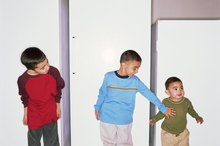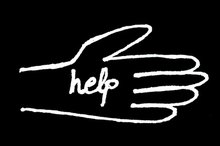Youth Activities on Forgiveness
Teaching a concept such as forgiveness to youth can be challenging. "Letting go of anger" and "moving forward" are abstract ideas to children when they do not have real-life experiences they can attach to them. However, children need to learn the important life skill of forgiving others because holding on to grievances saps you of your vitality and your compassion. Consider using hands-on activities to introduce the subject of forgiveness to young people. Arts and crafts, role playing and journaling are creative ways to help children identify their feelings. They also give young people a more concrete idea of what forgiveness might "look" like when dealing with a painful experience.
Skits and Role-Playing
Young children often enjoy pretending and role-playing is a fun way to introduce forgiveness to them. The Humanity Quest website suggests writing down a list of scenarios and acting them out with your child. Give him the chance to role-play both sides of forgiveness. For example, present a situation where a friend broke your youngster's toy and explore the feelings connected with this situation. Help your child think about how his friend might feel as the person who needs mercy and forgiveness and provide a few different phrases he could use to convey forgiveness -- "It's okay, I forgive you." or "I know it was an accident 3. It's alright." Role-playing is a good way to prepare for various situations.
- Young children often enjoy pretending and role-playing is a fun way to introduce forgiveness to them.
- Help your child think about how his friend might feel as the person who needs mercy and forgiveness and provide a few different phrases he could use to convey forgiveness -- "It's okay, I forgive you."
Collages
Reconciliation Activities for Kids
Learn More
Creating collages is another activity you can use to teach your children the principal of forgiveness, according to the Humanity Quest website 3. Give your child a large sheet of paper, crayons, markers, scissors, glue and a stack of old magazines or newspapers. Clip out an assortment of pictures together. Have her cut out photographs that represent a variety of emotions, including anger, sadness, embarrassment and fear, and label them. Explain to her how a person looks when she is hurt or upset. Next, have her cut out pictures that represent happiness, peace, contentment and joy. Place them alongside the first set of pictures as examples of how people might look when they are able to forgive.
- Creating collages is another activity you can use to teach your children the principal of forgiveness, according to the Humanity Quest website 3.
- Place them alongside the first set of pictures as examples of how people might look when they are able to forgive.
Journaling
Another good tool for teaching forgiveness is journaling. This exercise may be most beneficial to older children, but it is helpful for young children too. Give your child a notebook to record experiences he has had that warrant forgiveness 3. Encourage him to be as specific as he can in describing the event, how he felt about it at the time and how he feels about it now. It is easier to let go of bad feelings once you confront them. Psychologists refer to this process of recording your feelings on paper as "mental cleansing." Feelings left unacknowledged have the potential to fester. Journaling is a good way to explore your emotions without fear of judgment or repercussions.
- Another good tool for teaching forgiveness is journaling.
- Journaling is a good way to explore your emotions without fear of judgment or repercussions.
Related Articles
References
- Humanity Quest: Art Activities and Lesson Plans For Exploring Forgiveness
- Humanity Quest: Art Activities and Lesson Plans For Exploring Forgiveness
- PsychCentral: How to Teach a Child Forgiveness
- Toussaint LL, Shields GS, Slavich GM. Forgiveness, Stress, and Health: a 5-Week Dynamic Parallel Process Study. Ann Behav Med. 2016;50(5):727–735. doi:10.1007/s12160-016-9796-6
- Akhtar S, Dolan A, Barlow J. Understanding the Relationship Between State Forgiveness and Psychological Wellbeing: A Qualitative Study. J Relig Health. 2017;56(2):450–463. doi:10.1007/s10943-016-0188-9
- Lichtenfeld S, Buechner VL, Maier MA, Fernández-Capo M. Forgive and Forget: Differences between Decisional and Emotional Forgiveness. PLoS One. 2015;10(5):e0125561. doi:10.1371/journal.pone.0125561
Writer Bio
Michelle Ernst has been writing since 2000. She published a critical essay in "Annual of the Association for Mormon Letters" in 2004. She also wrote two athletic grants that were funded on behalf of the Because We Care Foundation of Lehi, Utah. She holds a bachelor's degree in behavioral science from Utah Valley University.









